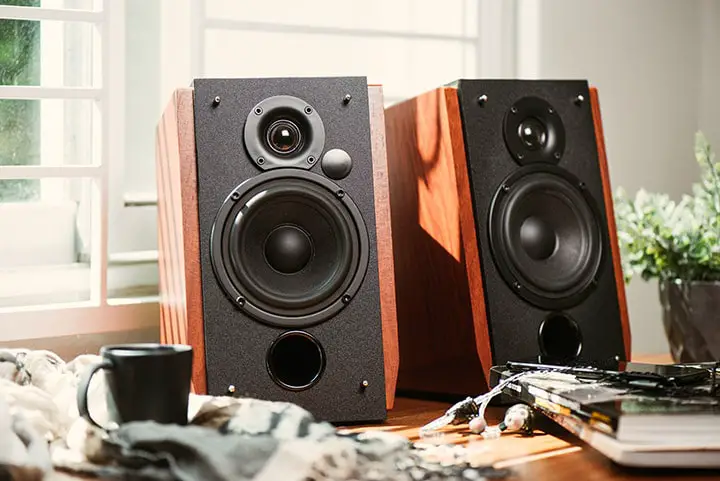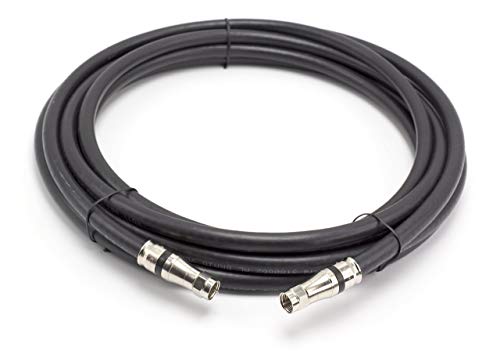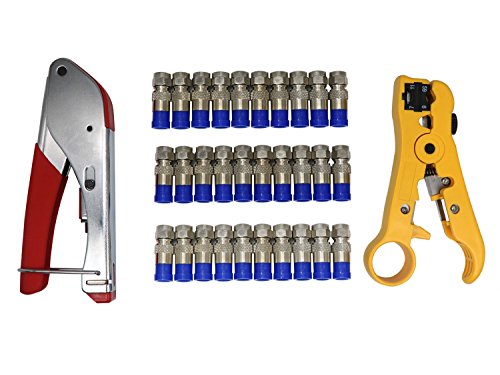Coax is a shortened term used to describe coaxial cable. Telecommunications companies and Internet providers globally use this wiring option because it effectively transfers audio and video data.
It didn’t take long for people to realize that high-speed communication needed a better transportation medium than what was available in the early 20th century.
Coax became the go-to option because it offers an accurate and reliable transmission.
The shielded design is what makes it such a successful product. Although coax will never compete with fiberoptics or more 21st century inventions yet to come, it could be a resource you can use as speaker cable at home.
Can You Use Coaxial as Speaker Cable?
Coax can work as a speaker cable, but it is not an efficient process to create this result. You’ll need to replace the standard F-connectors with an RCA end to make the setup work. The best option is to run a powered subwoofer with it, although any speakers theoretically work.
The issue with using coax as your speaker cable involves the impedance load it brings to the amp. Since you’ll have more resistance in the setup, you can’t drive it hard.
You’ll get sound at the risk of blowing everything out. This risk increases with the amount of distance you use with the cable.
Limiting the risk means bringing your equipment as close as possible to the coaxial cable.
When you keep things in the kHz range, you’ll generally have a safe routing experience that produces sound.
The quality of the sound may not be what you hoped it would be when wiring your system. If you don’t have any other choice, the coax works.
How to Use a Coaxial Cable as a Speaker Cable
Most people know that you can use coaxial cable to connect your cable or satellite feed to the television to watch your favorite sports, shows, and movies.
Some systems have a coax output that runs to other audio-video equipment setups to create a home theater system.
Although video applications receive the most attention, a coaxial cable is remarkably versatile. You’ll need to take some steps to overcome its lack of flexibility and overall thickness, but it can become your speaker wire.
These steps will take you through that process. Please remember to disengage the coax from any power source before starting this work.
- F-Type Connectors
- Tri-Shielded to Prevent Signal Interference
- Watertight and No Deterioration
- Outer Diameter: 0.4 inch (10.16 mm)
- Bandwidth: 3 GHz 14 awg
- Transmission Line: 75 Ohm
- Suitable for: CATV, DirecTV and Satellite Dish, Radio, VHF/UHF, Amplifiers, TV Antennas...
■ Step #1: Remove the Connectors
Most coaxial cables come with dual connections that route video signals from the wall to your television or box input.
You run the unit over the threading to create a secure connection. These items must come off if you’re going to use it as speaker wire.
A sharp utility knife will typically cut off the existing connectors. If you have an unusually thick coax with extra shielding, you may need to remove this layer before taking a small set of wire cutters to each end.
■ Step #2: Measure Your Length
Most coaxial cables come in six-feet length increments but this high-quality RG11 coax cable measures 50ft. If you have a custom TV setup at home that requires more length, you could have some extensive wire to use for your speakers.
You’ll want to measure how much is necessary to create the connections needed to produce sound.
To find how much wire you’ll need to connect your speakers, run a string from your amp or receiver to each location. Measure the length required to finalize the connection.
As a general rule, it helps to measure twice before cutting the wire length you need.
Since you can trim a longer piece to fit, try adding an extra couple of feet to your final measurement to ensure you’ve got enough reach for your setup.
Even if it is long, the extra slack will make the connection more manageable and offer additional stability.
- Coaxial Compression Tool
- Fitting Wire Stripper
- 30 PCS F Compression Connectors
- Adjustable Stripping Blade
- Compatible With: rg-6, rg-59, rg-58, bnc, rca...
- Compression Distance: 15.5-22.6mm for 59/6, 30.5-37.3mm for RG7/11
■ Step #3: Strip the Jacket
The fastest way to strip the insulation from the coaxial cable is to use a ringing tool. You’ll need to adjust the blade depth to match the coax’s jacket thickness to avoid damaging the wire it contains.
You’ll open the jaws of the tool, placing the coaxial cable in the notch that appears. Release the jaws, rotate the ringing unit several times, and you can typically pull off its jacket.
Unless the tool says it is made for coaxial cable like the one above, please do not assume that it is. Many multitools don’t provide the strength to get through the coax’s jacket.
If you don’t have a ringing tool, a sharp knife can let you cut through the jacket to reach the wire beneath. Once you get a side removed, peel the remainder away to expose the wire.
■ Step #4: Unbraid the Shields
Once you’ve removed the outer wrapper, you’ll need to get rid of the braided shield that protects the wire underneath.
The woven copper wire is usable for wiring your speakers if you can remove it without damage.
Slowly unwind the shielding so that you have one long copper strand to use for your audio setup.
If you have an RG6 coax that you’re taking apart for speaker cable, you’ll have a steel shield instead. Although you can theoretically use it for wire, it is better to get down to the conductor.
■ Step #5: Remove the Insulator
Once you unbraid the shielding on the coaxial cable, you’ll see a translucent insulation layer that protects the main signal conductor.
You’ll need a wire stripper available to remove this item to get to the core.
Continue to follow these steps until you have enough braided or core wire to create your speaker connections.
■ Bonus Step: An Alternative Connection Method
As an alternative to the five-step process, you could cut and strip approximately 1.5 inches of shielding, jacket, and insulation to expose the core wire at each end.
By keeping the rest of the cable intact, you’ll reduce the work while exposing the connections you want to use.
If you only strip the coax ends, you’ll lose the flexibility benefits that the bare core wire provides. You will save time, but the achievable results may not be satisfying.
This method tends to work better when you have several unused coaxial cables at home sitting in a drawer.
How to Connect Your Speakers Using Coax
Once you have the core wire and braids available to use from your coax deconstruction, it is time to connect your speakers.
Take the core wire, placing it with the red connector on your speaker. Take the other end to have it lead to the same color at the back of your receiver.
The braided strand should work with the black connector on a standard speaker, with the other end going to the same color at the rear of the receiver.
If you need to create a series or parallel connection with your speakers to your system, the same rules apply.
Use the core wire for all of your red (positive) connections, reserving the braided wire for the black (negative).
Once you have all of the connections in place, you should hear sounds coming from your speakers.
If you have a small system, using coax may make it sound about the same, and sometimes better, than using the wiring from the manufacturer’s setup.
When you have invested in a premier audio system with top-of-the-line speakers, coax is not your best choice for premium sound.
The limitations of the core wire restrict the overall quality of your listening experience.
Why Doesn’t Coax Work Well for Premium Speakers?
Most speakers don’t come with wire. That means it is up to you to choose the correct thickness, or gauge, and the type needed for your system.
When you purchase speaker wire, it may come with or without connectors.
Some manufacturers may provide this resource independent of the speakers that you’ve purchased from them, while others may include small units in the box to let you get the system running.
If you buy independent speakers to add to an existing system, you’ll need a new wire. Coax can work in a pinch, but it should not be your go-to solution for a permanent solution.
Wire thickness uses a measurement called American Wire Gauge (AWG).
The numbers work in reverse, which means a lower number indicates more thickness. If you need long wire runs, a 12-gauge or 14-gauge wire is highly recommended.
It would be best if you also used that option for low-impedance speakers or high-power applications.
When you have a short run to manage, defined as 50 feet or less, a 16-gauge wire will let you create the connections you need for an 8-ohm speaker.
Always try to follow the recommendations provided by the speaker’s manufacturer when creating your setup. If you use an AWG product that doesn’t meet with their specifications, there is a chance that your wiring could void the item’s warranty.
When you look at the AWG measurement on standard coaxial cable, you’ll see that it doesn’t stand up to the requirements.
- Most people have RG6 coax cable at home. It’s the standard product for connecting televisions to an incoming cable TV feed. This product is 18 AWG, making it smaller than what most standard connections require under 50 feet.
- If you don’t have RG6, you likely have an RG59 coax cable. This product is even smaller, providing a 22 AWG wire to use. It only works with extremely short connections, but even speakers less than ten feet away may experience sound quality issues when using this item.
- Some homes have an RG62 coax cable lying around to use. The inner core of this product is the same as an RG59, making it 22 AWG. Don’t be fooled by the higher number!
- If you have an RG58 coax cable, the inner core wire is a 20 AWG product. It’ll work better than the RG59 or RG62, but you won’t get the same quality that a thicker product could provide in a similar situation.
The best coax cable to use is an RG11. The conductor is 14 AWG, giving you the distance support needed for most speaker installations.
It meets all audio, video, Internet, and broadband expectations with minimal interference.
If you don’t have an RG11 coax cable at home, you can pick up some online for a reasonable price. You shouldn’t pay more than $1 per foot for this product.
- 100 Feet / 30.5 m
- Copper-Clad Aluminum
- Rugged PVC
- Easily Identifiable Polarity
- Soft Touch
You may also notice that traditional speaker wire gives you double the length for half the RG11 coax price.
If you have coaxial cable stored in a drawer, it may help you with your speaker connections. Unless you have RG11, it should be a temporary fix instead of a permanent solution.




